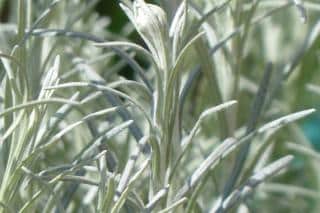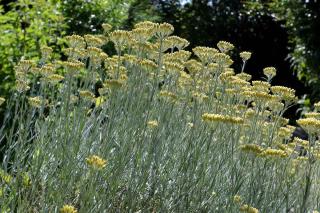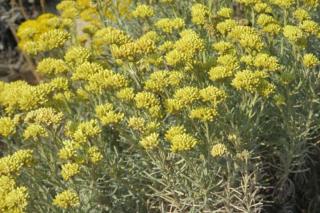

The Italian everlasting (Helichrysum) is a sub-shrub and also an herb, which is very interesting also for its cute little gold yellow flowers.
Italian everlasting Helichrysum facts
Name – Helichrysum italicum
Family – Asteraceae
Type – perennial
Height – 1 ½ feet (50 cm)
Exposure – full sun
Soil – ordinary
Foliage – evergreen
Flowering – June to October
A Mediterranean plant, it is often grown as an annual, but some species are hardier.
 Italian everlasting, or helichrysum, loves arid regions, well-drained soil and very sunny spots.
Italian everlasting, or helichrysum, loves arid regions, well-drained soil and very sunny spots.
Conversely, the Italian everlasting hates the cold or snow, because it wouldn’t survive it.
 Pruning isn’t really needed, all the more because Italian everlasting has a very slow growth.
Pruning isn’t really needed, all the more because Italian everlasting has a very slow growth.
But to keep a tight, compact bearing and a dense bunch, you can prune it at the end of winter so that you can give it a nice shape.
Luckily, it’s a bit more forgiving than lavender: Helichrysum is capable of sprouting new buds from old wood as long as you only cut less than half of the stems back entirely.
If your climate allows for it (mild climates such as the Mediterranean climate, or coastal climates along the Southern states of the USA), you can keep it in the ground from one year to the next.
However, to be absolutely sure it survives in areas with harsher climates, remember to mulch the foot of your everlasting to keep the roots from freezing.
Helichrysum is bushy and is well suited to perennial flower beds and also to growing in pots.
Helichrysum comes from ancient Greek ‘Helios’ which means “sun” and ‘chrysos’ which means “gold”, referring to the gold yellow of its flowers.
If it is called Everlasting, it’s because its flowers when dried have such an extended lifespan that it becomes immortal…
Its gray colored foliage, quite bright, sometimes reminds one of that of lavender.
 Flower tips of this particular species, Helichrysum italicum, are distilled to produce an essential oil.
Flower tips of this particular species, Helichrysum italicum, are distilled to produce an essential oil.
Leaves are used to spice meals because its taste is very close to that of curry.
Take care though not to swallow the leaves since they are rather indigestible and can cause digestive disorders.
This plant is also used to produce essential oil extracts for its medicinal properties. Compounds in this plant’s essential oil are known to have antioxydant, antibacterial, analgesic and antifungal properties.
If you find that caring for plants is more of a chore, splurge for Helichrysum which doesn’t require any care at all!
My curry plant never seems to flower
Hi Anne! That’s curious. Would you share pictures so I can try to see what might be happening?